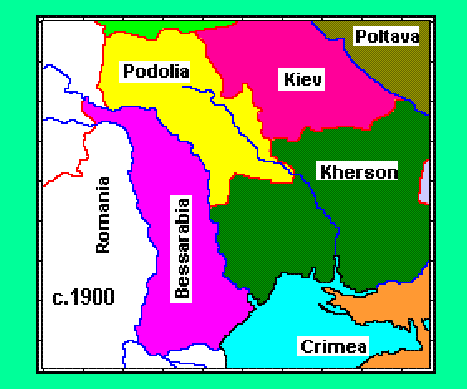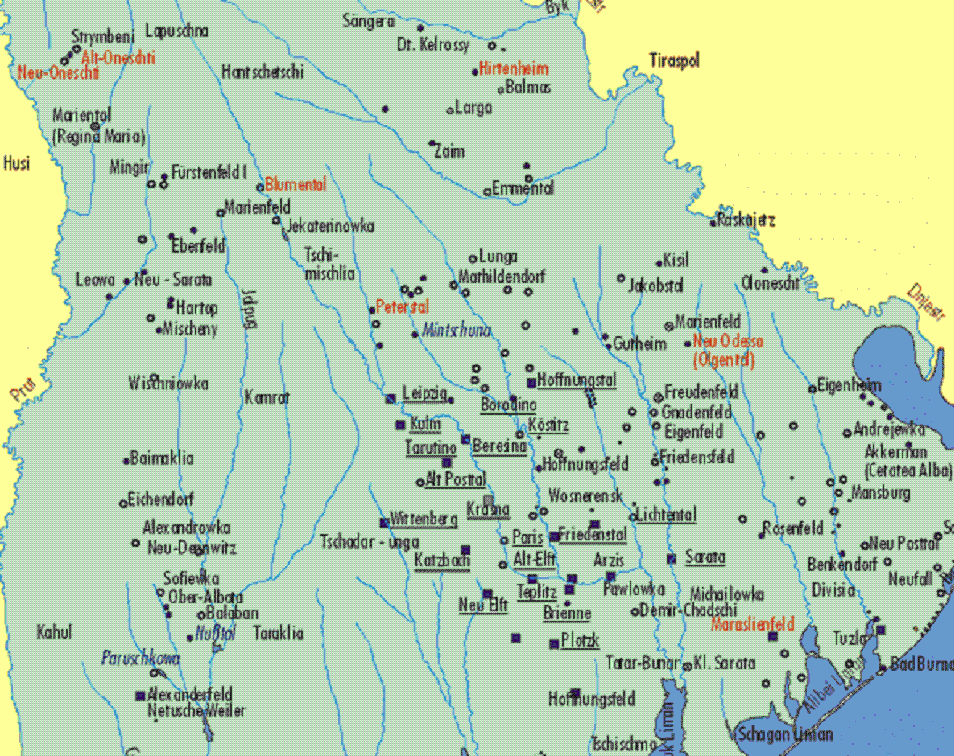
The Germans from BessarabiaDefinitionBessarabia is a former region of Eastern Europe, comprising most of the current-day Moldavian Republic and a small piece of southern Ukraine. It was bounded by the Dniestr river to the north and east, the Prut to the west, and the lower Danube and the Black Sea to the south. 
Source: http://www.zum.de/whkmla/histatlas/balkans/mold1900s.gif> SettlementGerman colonization of Bessarabia began in 1812 when Russia acquired this territory from the Ottoman Empire. Tsar Alexander I. issued an invitation to Germans—mainly in the Duchy of Warsaw—to settle in this still comparatively empty region. These Germans had migrated there from several German states—especially Prussia, Wurttemberg and Baden—to colonize the Prussian districts after the first partition of Poland. When these regions became part of the Duchy of Warsaw and were suppressed by the state and fell into misery and hunger, many of the German settlers were willing to follow the Tsar's call. Germans from southwestern Germany, particularly Wurttemberg, also responded to the invitation. That region was seriously depressed because of the Napoleonic wars and suffered under the arbitrary rules of the princes, high taxation, religious quarrels, and many failed harvests. The Tsar promised the settlers—as Catherine the Great had done before in 1763—free land (65 hectares), exemption from military service, and religious freedom. Between 1814 and 1842 about 9,000 Germans migrated to Bessarabia and founded 25 mother colonies on about 150,000 hectares of land given to them by the state. Because of their high birth rate, the number of colonists increased to 25,000 by 1842, leading to a sharp increase in demand for new land. As it became available, daughter colonies were established. In this manner, more than 150 communities were set up in the 125 years of German settlement in Bessarabia. Between 1861 and 1919 the German population of Bessarabia rose from 33,000 to 79,000, accounting for three percent of the total. The highest concentration of Germans was found in the Akkerman Kreis where they represented more than 16% of the population. 
Source: http://jethon.de/html/geografie_und_geschichte.html But some colonists left Bessarabia again. Large numbers emigrated in 1874 when the exemption from military service was lifted. (Until 1939, altogether 19,000 Bessarabians would emigrate, of whom 11,320 would go to North America—most of them in 1902 [1]—and another 2,000 to South America). Although relationships between the Germans and Russians in Bessarabia were generally good, pressure from the nationalist and Pan-Slavist movements led to a continuous decline in the number of privileges that the German colonists had been granted. Their situation deteriorated even more with the outbreak of the First World War. German schools were closed, and German services and newspapers were prohibited. They lost much of their land and were threatened with mass evacuation to Siberia. However, the severe winter and the Revolution of 1917 kept them from this fate. After Bessarabia had become part of Rumania in 1918, the liquidation and expropriation laws were repealed. Although the colonists received their land back, the German schools were allowed to reopen, and church services could be offered in German, many of the concessions were soon once more withdrawn. The following two decades would, however, be characterized by considerable economic prosperity and cultural development as the Bessarabians tried to retain their German heritage and to be loyal Rumanian citizens at the same time. At the end of the 1930s they were even allowed to establish church schools again. In the 1930s, 2.8% of the population of Bessarabia was German. There was an active cultural life among the Bessarabian Germans: In 1940, 61 villages had German libraries, the teachers' organization and the Hochschulverband with its collection of books, and there were five German bookstores. [2] In 1940, Bessarabia and northern Bukovina were occupied by Soviet troops. Against the background of the Hitler-Stalin-Pact it was agreed to resettle the more than 93,000 Bessarabian Germans to the Reich. They were allowed to take along food, furniture and agricultural implements, but were not compensated for their homes and whatever wealth they had accumulated. They wound up primarily in camps in Saxony, Franconia, Bavaria, the Sudetenland, and Austria. After difficult times in the resettlement camps, the great majority of the Bessarabians was resettled on farms in the Warthe-Gau and West Prussia in 1941/1942 from which their Polish owners had recently been expelled. Many Bessarabians were aware of the fact that they had displaced another ethnic group for their own advantage, but did not ask many questions. In January 1945, Russian troops advanced on the regions where the Bessarabian Germans had been settled, and while trying to flee the Germans suffered tremendous losses. Those who made it came to Mecklenburg, Brandenburg, Saxony, Lower Saxony, and Holstein. Others were deported to the Caucasus and to Siberia. Settlement in AlbertaAround 1902, a sizable number of German-Russian homesteaders, mostly Bessarabians, settled southeast of Medicine Hat in farmland stretching towards the Cypress Hills. Eberhardt estimated that at that time there were ca. 630 speakers of Bessarabian German in Medicine Hat. However, not all had come directly from Russia, many arrived via North Dakota. According to her calculations, an estimated 4,000 speakers of Bessarabian German from Russia, Germany, the U.S. and elsewhere in Canada resided in the Medicine Hat area in 1961. [3] Notes[1] Eberhardt, Elvira, The Bessarabian-German dialect in Medicine Hat, Alberta. Ph.D. dissertation (Edmonton: University of Alberta, 1973), p. 23. [2] Eberhardt, p. 21. [3] Eberhardt, pp. 24-25. Sources1. "Bessarabien: Eine Heimat in der Fremde," http://jethon.de/html/deutsche_siedler.html. 2. "Die Bessarabiendeutschen," http://www.bessarabien.de/bess/start.htm. |
